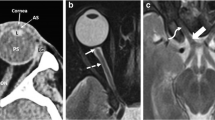Abstract
Acute ocular trauma accounts for a substantial number of emergency department visits in the USA, and represents a significant source of disability to patients; however, the orbits remain a potential blind spot for radiologists. The goal of this article is to review the relevant anatomy of the orbit and imaging findings associated with commonly encountered acute ocular traumatic pathology, while highlighting the salient information which should be reported to the ordering clinician. Topics discussed include trauma to the anterior and posterior chamber, lens dislocations, intraocular foreign bodies, and open and contained globe injuries.















Similar content being viewed by others
Change history
11 July 2017
An erratum to this article has been published.
References
Channa R et al (2016) Epidemiology of eye-related emergency department visits. JAMA Ophthalmol 134(3):312–319
Kuhn F et al (2002) Epidemiology and socioeconomics. Ophthalmol Clin N Am 15(2):145–151
Bahrami S, Yim CM (2009) Quality initiatives: blind spots at brain imaging. Radiographics 29(7):1877–1896
Turvey TA, Golden BA (2012) Orbital anatomy for the surgeon. Oral Maxillofac Surg Clin North Am 24(4):525–536
Hayreh SS (2006) Orbital vascular anatomy. Eye 20(10):1130–1144
Rene C (2006) Update on orbital anatomy. Eye (Lond) 20(10):1119–1129
Kubal WS (2008) Imaging of orbital trauma. Radiographics 28(6):1729–1739
Bowling B (2016) Kanski’s clinical ophthalmology: a systematic approach. Elsevier, London
Weissman JL et al (1995) Enlarged anterior chamber: CT finding of a ruptured globe. Am J Neuroradiol 16(4):936–938
Arey ML et al (2007) Computed tomography in the diagnosis of occult open-globe injuries. Ophthalmology 114(8):1448–1452
Loporchio D et al (2016) Intraocular foreign bodies: a review. Surv Ophthalmol 61(5):582–596
Koo L et al (2005) Gender differences in etiology and outcome of open globe injuries. J Trauma 59(1):175–178
Yuan WH et al (2014) CT of globe rupture: analysis and frequency of findings. AJR Am J Roentgenol 202(5):1100–1107
Patel SN et al (2012) Diagnostic value of clinical examination and radiographic imaging in identification of intraocular foreign bodies in open globe injury. Eur J Ophthalmol 22(2):259–268
Fulcher TP, McNab AA, Sullivan TJ (2002) Clinical features and management of intraorbital foreign bodies. Ophthalmology 109(3):494–500
Lakits A et al (1999) Orbital helical computed tomography in the diagnosis and management of eye trauma. Ophthalmology 106(12):2330–2335
Gor DM et al (2001) Radiologic differentiation of intraocular glass: evaluation of imaging techniques, glass types, size, and effect of intraocular hemorrhage. AJR Am J Roentgenol 177(5):1199–1203
Yamashita K et al (2007) An intraorbital wooden foreign body: description of a case and a variety of CT appearances. Emerg Radiol 14(1):41–43
Ho VT, McGuckin JF, Smergel EM (1996) Intraorbital wooden foreign body: CT and MR appearance. Am J Neuroradiol 17(1):134–136
Sung EK et al (2014) Injuries of the globe: what can the radiologist offer? Radiographics 34(3):764–776
Johnston PB (1991) Traumatic retinal detachment. Br J Ophthalmol 75(1):18–21
Joseph DP, Pieramici DJ, Beauchamp NJ Jr (2000) Computed tomography in the diagnosis and prognosis of open-globe injuries. Ophthalmology 107(10):1899–1906
Li X, Zarbin MA, Bhagat N (2015) Pediatric open globe injury: a review of the literature. J Emerg Trauma Shock 8(4):216–223
Bord SP, Linden J (2008) Trauma to the globe and orbit. Emerg Med Clin North Am 26(1):97–123 vi-vii
Salvin JH (2007) Systematic approach to pediatric ocular trauma. Curr Opin Ophthalmol 18(5):366–372
Author information
Authors and Affiliations
Corresponding author
Ethics declarations
Conflict of interest
The authors declare that they have no conflict of interest.
Additional information
The original version of this article was revised: The correct article title is: “Acute ocular traumatic imaging: what the radiologist should know”.
An erratum to this article is available at https://doi.org/10.1007/s10140-017-1536-0.
Rights and permissions
About this article
Cite this article
Thelen, J., Bhatt, A.A. & Bhatt, A.A. Acute ocular traumatic imaging: what the radiologist should know. Emerg Radiol 24, 585–592 (2017). https://doi.org/10.1007/s10140-017-1528-0
Received:
Accepted:
Published:
Issue Date:
DOI: https://doi.org/10.1007/s10140-017-1528-0




